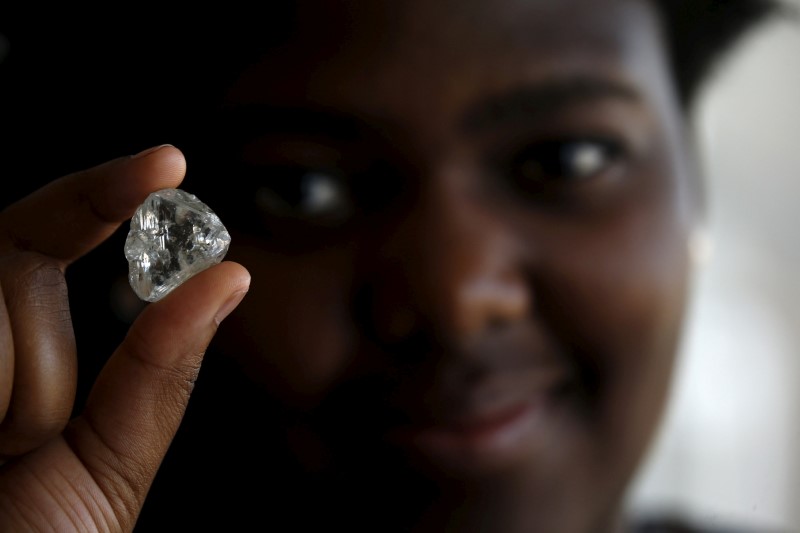Image: A visitor holds a diamond during a visit to the De Beers Global Sightholder Sales (GSS) inGaborone, Botswana November 24, 2015. REUTERS/Siphiwe Sibeko/File Photo
By Ed Cropley
GABORONE (Reuters) – When David Magang opened Botswana’s first domestic law firm shortly after independence in 1966, he and his country were starting from scratch.
Since then, both he and the former British protectorate, which celebrates its 50th birthday this week, have traveled a huge distance based largely on Botswana’s vast diamond wealth. With those riches running low, the outlook is less rosy.
Trained in London, Magang was one of only two local lawyers – the rest being British or South African – while Botswana, an expanse of arid scrubland the size of France, had just 7 km (4 miles) of tarred road and a capital that amounted to little more than a railway station.
“On the face of it Botswana was very poor – good for hunting and not much else. It was basically an agrarian, subsistence society,” Magang told Reuters. “All we had was a railway, and that was owned by South Africa and Rhodesia.”
The 77-year-old is now chairman of a luxury golf and housing estate on the outskirts of Gaborone – still known by some as ‘The Station’ – while Botswana is the world’s biggest diamond producer and one of Africa’s richest and most stable countries.
Its road network stretches for nearly 7,000 km, the government’s credit rating is the highest on the continent and per capita income has risen 13-fold to $7,000 thanks to growth averaging 8.2 percent a year, according to the World Bank.
Over the past half century, only South Korea and China boast such dramatic increases in national wealth.
“I compare it to an ant and an elephant,” President Ian Khama, the son of founding father Seretse Khama and his British wife, Ruth, told Reuters in his wood-panneled offices in the heart of Gaborone’s bustling government district.
Outside his window, laborers hammered away near high-rise apartment and office blocks more akin to Dubai than the sleepy town romanticized in British author Alexander McCall Smith’s tales of Ma Ramotswe and her ‘No. 1 Ladies’ Detective Agency’.
“It’s chalk and cheese when you compare what the country looked like back then to what it is now,” Khama said.
“EATING DIAMONDS”
To mark the 50-year milestone, armies of state workers have festooned street-lights with flags and daubed roadside rocks with sky-blue paint, Botswana’s national color.
But the celebrations are also tinged with unease.
The cornerstone of Botswana’s success has been one commodity, diamonds, coupled with a rigid adherence to prudent use of their revenues, a rarity on a continent where natural riches are routinely squandered, stolen or the cause of civil war.
Besides roads, they have funded hospitals, schools and a welfare state that provides free healthcare and education to all, generous by African standards. There is also a $5.4 billion sovereign wealth fund and $8 billion in central bank reserves.
But each of Botswana’s 2.3 million people knows that, unlike in the movies, the gems do not last forever, and the breakneck growth they have fueled in the past will not be repeated.
Even if output remains constant, with a growing and aging population – life expectancy has risen to 64 despite one of the world’s worst HIV/AIDS epidemics – the net effect is a per capita windfall that shrinks a fraction each year.
“In a sense, we are eating diamonds,” said economist Keith Jefferis of Gaborone-based econsult. “There is no immediate threat to Botswana’s current ‘business model’ but diamond mining is unlikely to provide economic growth in the future.”
NEED BETTER PEOPLE, NOT ROADS
In response, the government has achieved some success in its attempts to wean the economy off diamonds.
Mining made up just one fifth of GDP last year compared with half in the late 1980s at the height of the diamond boom, while financial services and tourism – the Okavango Delta is one Africa’s premier safari destinations – are growing fast.
But Botswana’s banks and hotels are not generating sufficient numbers of jobs to satisfy a population used to rapidly improving standards of living. Unemployment is stuck above 20 percent and is more than double that for young people.
“So many graduates are just street-walking with no jobs,” said Marks Leselwa, a 53-year-old labor claims adjudicator in Gaborone. “I’m worried by the fact that there is no employment.”
This is not to say Botswana is doomed.
Improvements in mining technology and new discoveries mean the ‘end of diamonds’ once forecast for 2018 has been pushed out to as late as 2050, Khama said, giving time to address one acknowledged failing: high-quality education.
“Modern economies are propelled by people who have been properly trained. One of the mistakes we made is not training people to be doers and creators,” Magang said. “But I’m an optimist. We can easily fix that.”
(Reporting by Ed Cropley; Editing by Richard Balmforth)
Copyright 2016 Thomson Reuters. Click for Restrictions.


